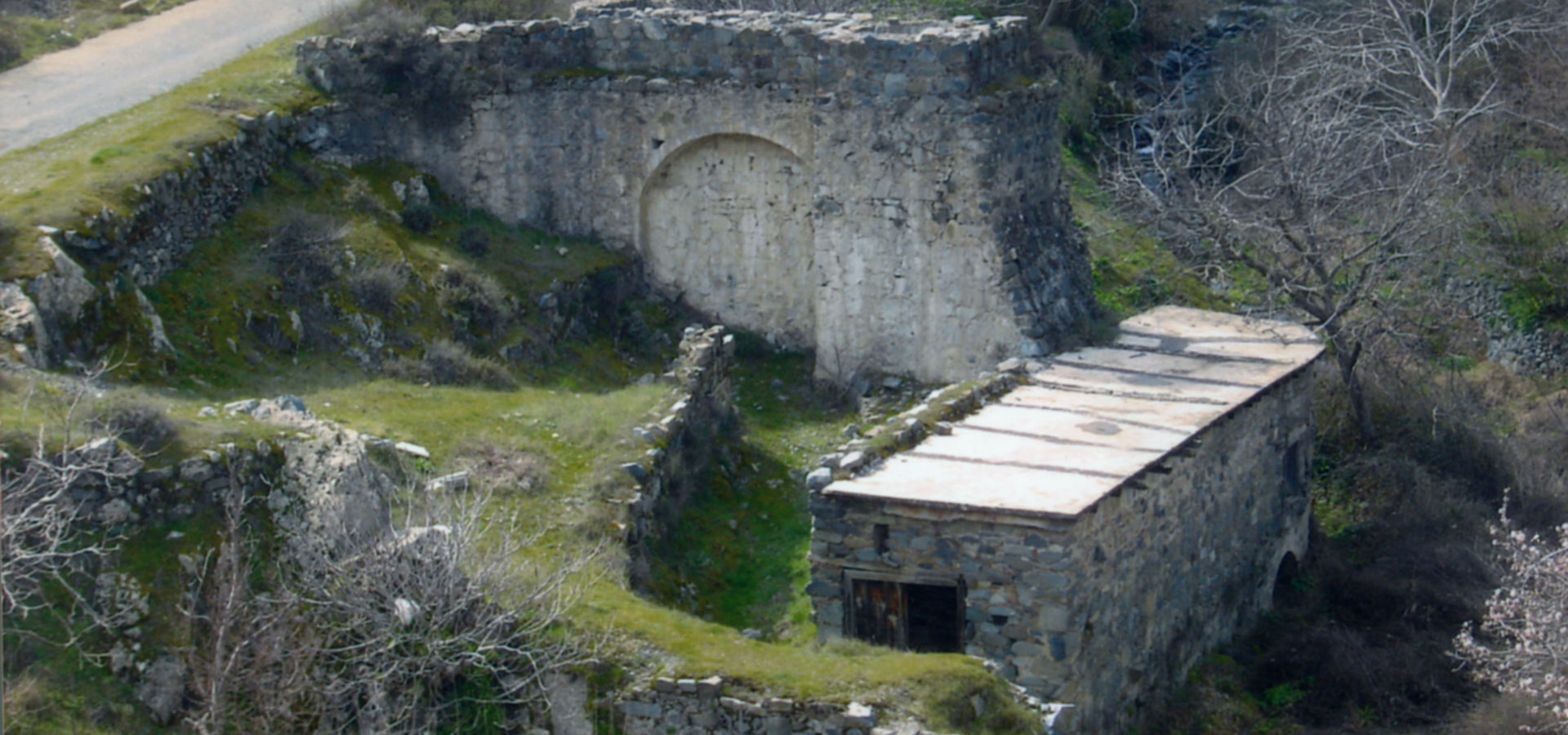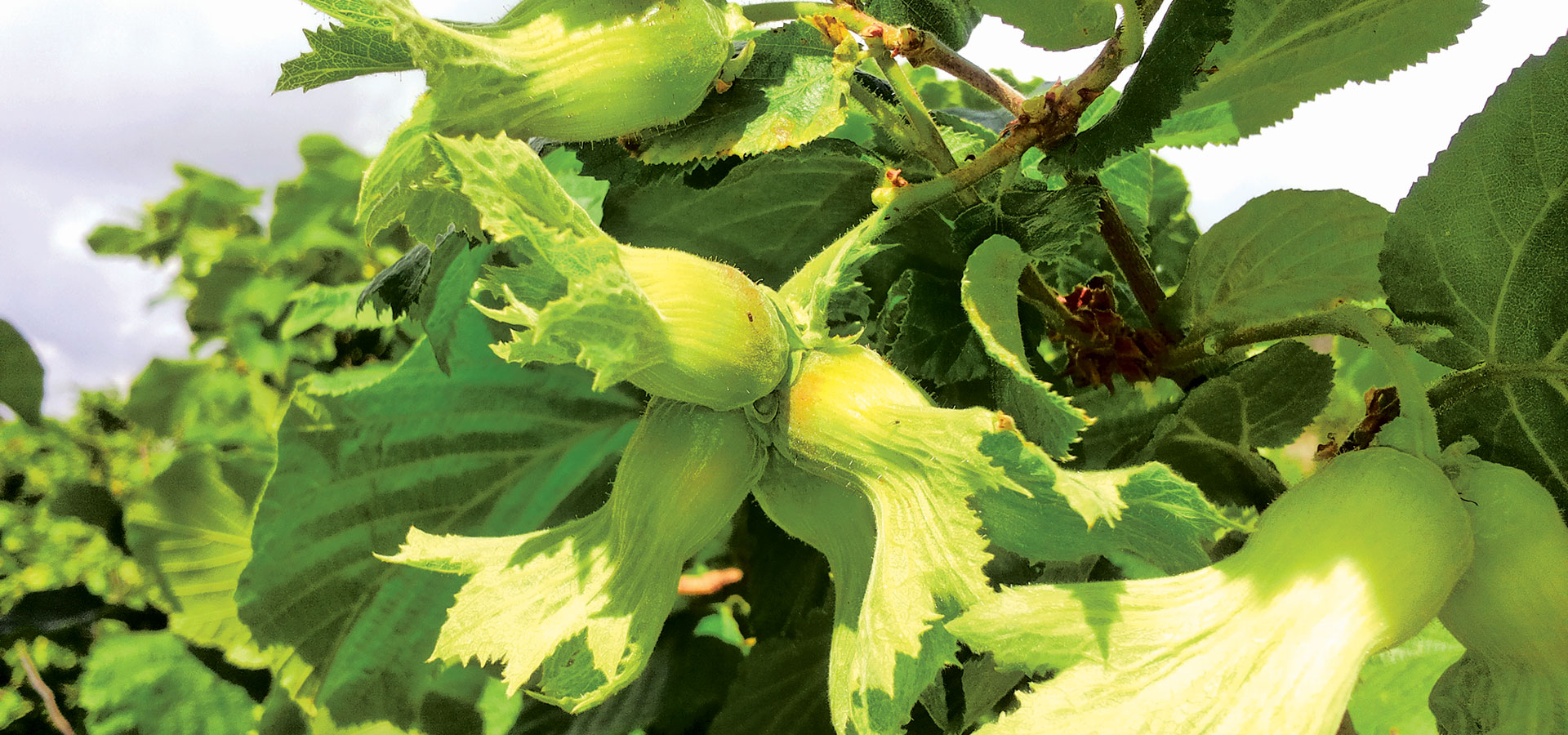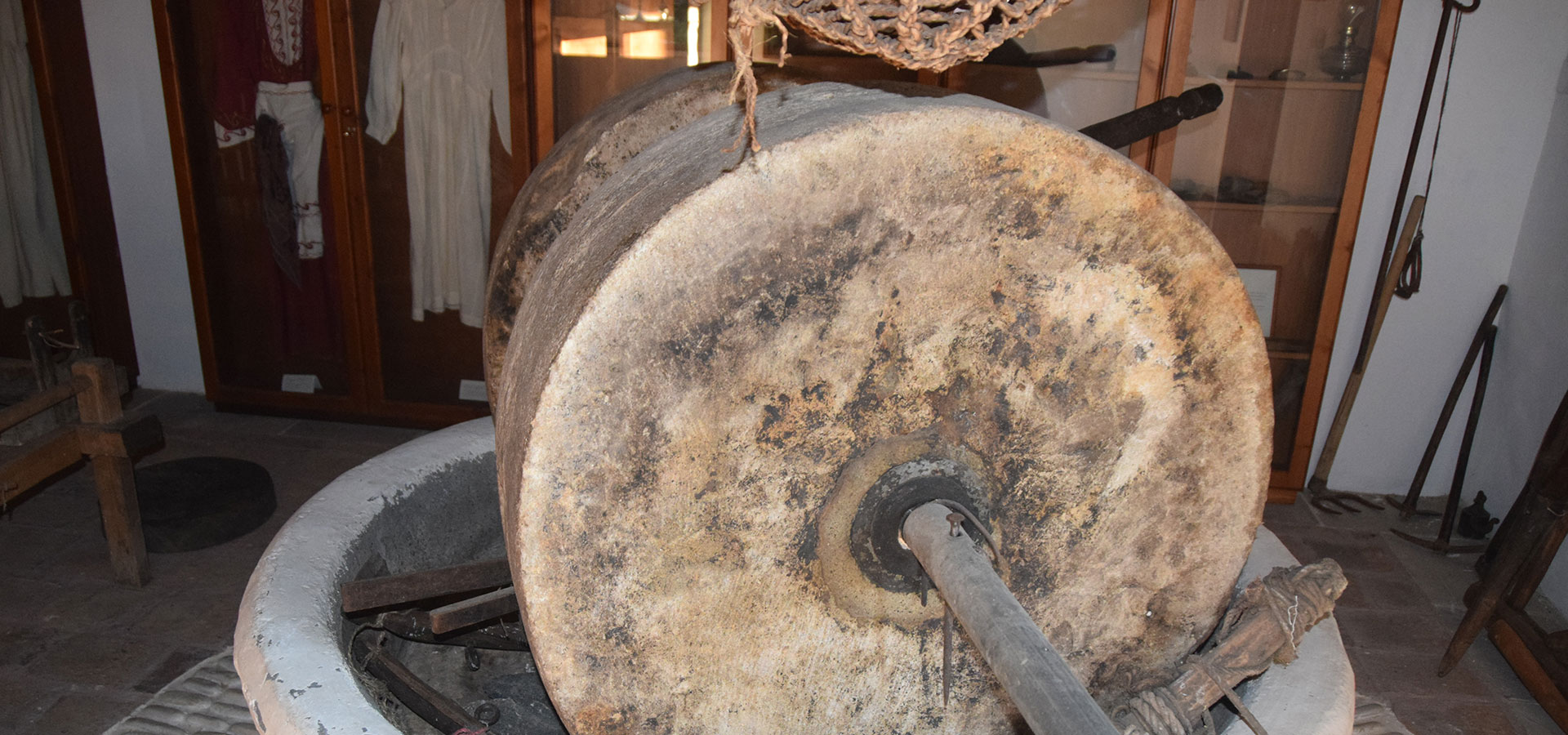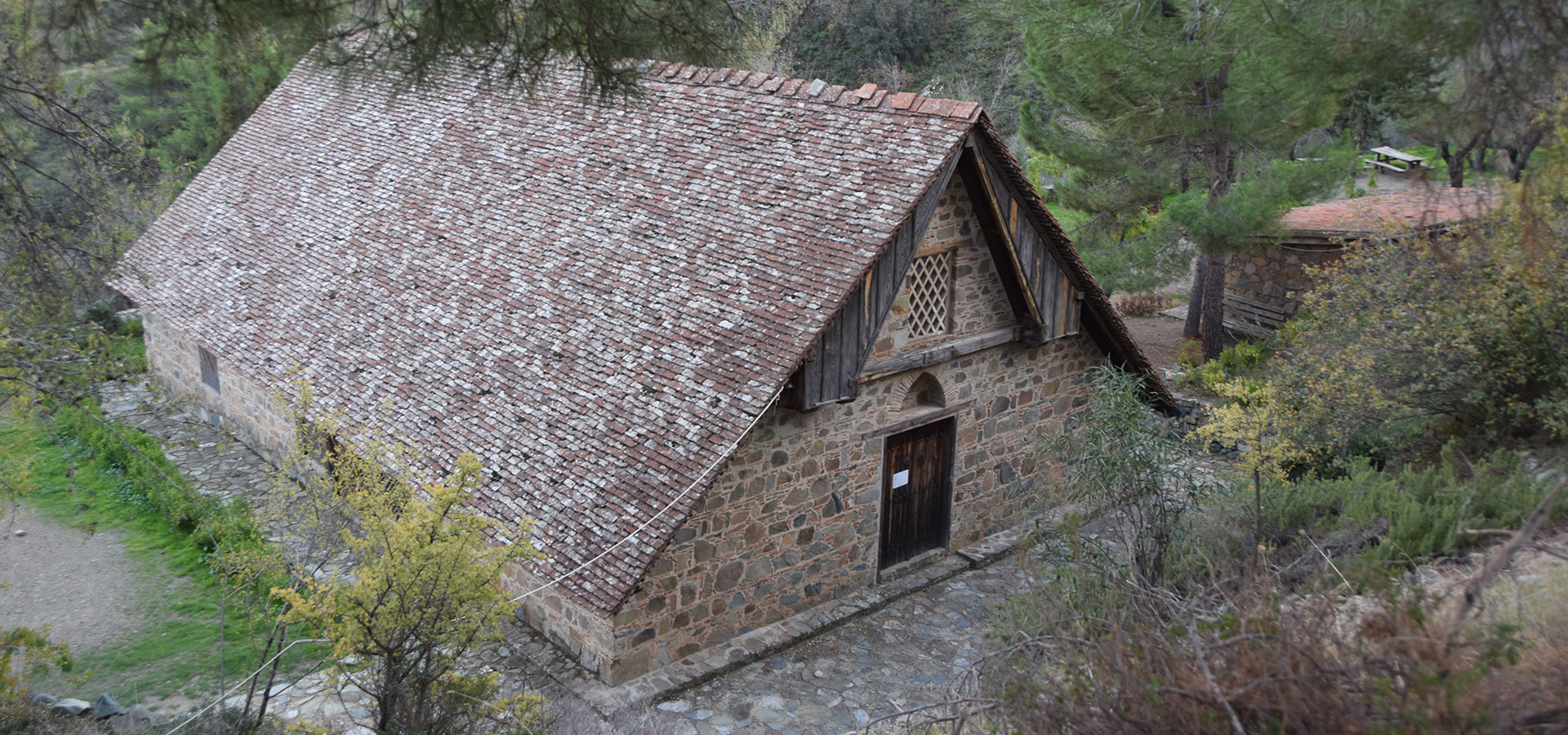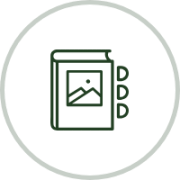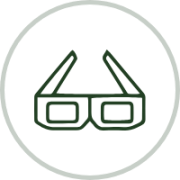History
The small beautiful village of Pitsilia with the long lasting history and the incomparable beautiful monuments.
Platanistasa is a pure Greek village of the province of Nicosia found in the heart of the rough ground of Pitsilia region, in the northern side of Troodos. If you follow the street of Nicosia-Peristerona-Orounta-Kato Moni- “Gefyri tis Panagias” the distance of the village from Nicosia is about 58 kilometers. If you take the street of Nicosia – Anthoupoli – Agrokipia – “Gefyri tis Panagias” the distance from Nicosia to the village of Platanistasa is only 40 kilometers.
The village of Platanistasa is built at an average altitude of 940 meters. The landscape where the village is found consists of rough mountains with narrow deep valleys and abrupt mountaintops that their height exceeds the 1000 meters. The river of Peristerona, Serrachis, dismembers the entire landscape.
Archaeological discoveries and remnants, (pre-Christian graves in the region of the Municipal School and the altar at an elevated location above the cafes at the center of the village), testify how deep are the roots of this village. Homeric authentic words like “nostos”, “linos”, “domi”, “doma”, “ornitha”, “aiga”, “rifi”, “rous” are used daily up to today by the residents of the village testifying the Greek character of this village many years ago.
Remnants of devastated settlements in the regions “Peratides-Dipotamia”, “Vrysi tis Zintilas”, “Aspri”, “Marathos” and elsewhere, testify the unceasing habitation of the region of the community.
Names like “Louvaras “(water place),” Vikla”(Observatory),” Klados tou Rousia”(from the Franc noble Bernard De Riosser, famous admiral of Carlotta, named by the Cypriots as” Nte Rousia”) and “Vasilias” in the middle of village, prove the life of village during the Franks dynasty in our island. According to the medieval chronicler Georgio Voustronio the village of Platanistasa was granted together with other villages in January 1474 to Georgios Kontarinis, Count of Giafas, that was a relative of the Queen of Cyprus, Aikaterini Kornaro.
In old maps the village of Platanistasa is marked as “Platanista” or “Piatanista”.
There are three versions for the name of the village Platanistasa:
First version:
From the tree “Platanos” – (plane tree). Platanistasa means a locality full of plane trees.
Second version:
The village took its name from the “Palace”, the rural palace of the Franc nobles and the Royal family that was found at the center of the current village in the region “Vasilias”. Platanistasa here means: The County found round the Palace. Palatistasa-Platanistasa.
Third version:
The third version is relative with the “horseshoe” shape of the village that looks like with “platana”. Platana is a metal having the shape of a horseshoe placed under the rear part of the “podines” mainly called “tsangaropodines”, local footwear of the residents of Pitsilia region in the old years.
Tour
Platanistasa COOP donated a plot for the construction of the community surgery.
The Platanistasa village of the Lefkosia District is situated on an altitude of about 3000 feet on the mountain region of Madari-Papoutsa, in the Pitsilia region.
The present living inhabitants of the village are about 150. The decrease of the population in no way affects the picturesque beauty and charm of the environmental and tourist attractiveness of the village.
Sights, landmarks for Platanistasa which are worth to be seen by the visitors:
- The unique in Cyprus and excellent in beauty green community square in the centre of the village, from which the thousands of visitors enjoy the panoramic view of the protected green valley of the hazel forest, which spreads beyond it.
- The unique in Cyprus green car park, a sight for sore eyes in spring, the blooming almond groves, innumerable brides, in the sight of which the astonished visitors monologue: (if this is not heaven, where else could it be?)
- The Byzantine Church of Stavros of Agiasmati, a protected by UNESCO monument of Global Cultural Heritage
The visitor can be supplied with traditional coldcuts of excellent quality from the local coldcut factory.
Strolling around the village with the surrounding forestry hills, the narrow picturesque alleys, the nature’s paths and the beds of the small rivers, is an opportunity of ecological traditional housing “pleasure” and recreation
Source:
President of Association of Expatriates, Mr Frixos Kyriakides
Projects
Completed
The community council of Platanistasa has set the goal of creating a community that provides its people with all modern comforts. Within this frame, and so as to achieve this goal, its has already accomplished many projects, that have improved the face of Platanistasa.
Some of these projects are:
- Restoration, conservation and conversion of the old olive-press into a Folk Art Museum.
- All roads in the village are paved with slabs.
- Construction and embellishment of LAOUDE and KAPSALI squares.
- Embellishment of the “KYPRIANOU KOUPPA” central square.
- Water pipes leading to the monastery of Agiasmati were installed.
- All rural roads are now asphalt roadways.
- Construction of irrigation system with bores for water and installation of automatic irrigation systems.
- Construction of Community Park, where a monument dedicated to the victims of the second world war is located.
Schedule
- Construction of 3 natural pathways:
Α) A natural pathway starting from the old olive-press, leading to the double tanks
through the filbert forest.
Β) A natural pathway starting from Platanistasa leading to the nearby village Alethinou.
C) A natural pathway starting from the filbert forest, leading to Vasilias area. - Construction of buildings covering the needs of the community council.
- Platanistasa COOP donated a plot for the construction of the community surgery.
Natural Contribution
THE CONTRIBUTION OF PLATANISTASA IN THE NATIONAL FIGHTS
Platanistasa is found at the heart of the land that gives birth to heroes ,at Pitsilia.Its residents ,grown up with the national and religious lectures ,by the glowing Bishops such as the ever memorable hierarchs ,Kyrrilo Papadopoulo,Kyrillo Vassiliou ,Makario myrianthea and Kypriano Kyriakidi and the national Apostles teachers of that time , having as first the fortunate Hristodoulo Kantho,Evagora Papanikolaou and others who were thunderously present in the fights of the Nation and Cyprus. Platanistasa offered fighters, to the bloody fields of honour, to the Nation’s struggle and the free Nations, for the freedom of the unredeemed brothers and against those who wanted to conquer people, in their rapaciously regimes. At the same time the residents offered money from their savings for Mother Greece when they were asked to do it from their religious leadership that was a member then, the Ethnarc church of Cyprus. They offered what they had and did not have without hesitation for the sacred aim that their leadership asked them. Gold crosses ,bracelets ,earings,wedding rings, gold pounds everything was offered at charities at the Balkan wars ,in the Near East expedition and later for the refugees and injured in the Near East destruction, to buy an aeroplane’KYRENIA’a gift from the Metropolitan District of Kyrenias to Mother Greece (1926-28)(2),during the second world war and at the struggle of the bloodshed Nation, against the motivated by foreigners gangsters (1946-1949).
During the Balkan Wars and the A and B World War the Residents of Platanistasa run in great numbers ,to offer their services to the in favor of freedom fights as volunteers and under the British Flag. Cyprus was then under the British domination. (Since 1878-1959).
During the second World War ,two boys of Platanistasa ,who served in the British expeditionary corps ,which was sent to Greece ,the blessed Efstathios Savva Piassouli ΑΣΜ 1974, and Modestos Papaefstathiou , ΑΣΜ 4215,fell fighting the first on the 21/4/1941 and he is buried on the Military cemetery of Faliro.Their blood watered the ground of Greece .The other one from our village the blessed Panagiotis Tsiolis died when he was on a ‘commanded mission’ in Cyprus.
During the Epic Liberating fight of 1955-1959, the whole community of Platanistasa vividly gave its presence. A big part of the residents took part in this fight under the flag of the legendary ΕΟΚΑ and under the policy and guidance of the Archbishop Makarios the third and the military leadership of the Colonel of the Greek Army from Cyprus (from Trikomo)Georgiou Theodorou Griva the legendary DIGENIS.
We won’t mention any names so we are fair to everyone .It will be enough to mention those who were guerrillas, persecuted and ‘followed the paths, to find the steps that lead to freedom’. These are:
Savvas Papaefstathiou (Komitis), who was a Section Head in Paphos, under the nickname ‘Rados’and had as his brother-in arms, among others, the hero, poet and martyr of the gibbet Evagora Pallikaridi.
Haralambos Efstathiou, with the nicknames ‘Daedal’ and Vrahos’(rock),who served in the team of the leader Digenis in the mountains of Kykkos and under the commands of the pure hero the Christian fighter Marcos Drakou and
Andreas Hadjinikolaou (Johhnys), who had the nickname ‘Saktouris’and served at the area of Pitsilia in the beginning and at the area of Mahera in the end; he was a compatriot of Savva Rotsidi.
A great number of the residents of Platanistasa ,due to the action in the Liberating fight was drawn in the detention rooms ,at head our respectable priest Efstathio Kouppa, these people were in detention awaiting trial ,were tortured ,suffered .But they did not bend ,did not betray.
One, from our village Takis (Hristos) Michael Passioulis was convicted in ten years sentence for carrying a bomb.
At Platanistasa, there was a lab for bomb construction,a kind of water pipe .in the machine shop of Antoniou Georgiou who even though he was from Kakopetria was married at Platanistasa.He had as a companions Panos Perdikis ,Panagioti Pontico and his young employee Antoni Kyritsis.
The biggest part of the human resources of Platanistasa worked at the Mitsero Mine then. Many people, because of this work, suffered from the pneumoconiosis disease. But because most of them were joined in EOKA were commanded to stay in their jobs, despite their disease, in order to supply the Organization with dynamites. So they followed the demands of, defying the dangers, of Pneumoconiosis and the dynamite transportation because if they had been arrested by the English their consequent conviction would have been death through hanging .Because of pneumoconiosis these people were led to premature death.
At Platanistasa there were as hideouts the houses of:
- Andrea Hadjinikolaou Johnny
- Panayioti Pontikou
- Demosthenes Aspri
- Savva Hadjithoma
- Kyriakous Efthimiou, who as an active member of EOKA had the name ‘Demetra
During the Turkish mutiny (1963-64),long before there was the organised Army ,a great number of the residents of Platanistasa voluntarily contributed their services to Country especially as Special policemen .During the barbaric Turkish Invasion (1974), except the recruit soldiers who served on the National Army Forces ,all the rankers of Platanistasa hurried to volunteer and be transferred at the battle fields to fight the barbaric Turkish Intruder .One of them was Odysseas Savva Spetsiotis ,there in the carbonised, from the fires that the bombs of the enemy lit, ground of Pentadaktylos,at the village of Agios Ermolaos on the 26 July ,on the same day of Saint Ermolaos celebration ,fell from the Turkish fires ,defending our Cyprus integrity.
In the list of the missing persons of the Turkish Invasion there are the names of:
- Savva Hadjikyriako, who came from Platanistasa and was married in Akaki.
- Georgiou Andrea Hadjikyriakou ,a resident of Neapolis ,whose father came from Platanistasa
- Giannaki Pastou who lived in Nicosia and his mother was from Platanistasa
Histories from the past
The horrible drama of the miners who suffered from pneumoconiosis (Pneumoconiasmenoi)
The poem narrates the tragic situation of the miners who were forced to “enter the bottom of the Earth” and risk their lives in order to make a living. The poet, with a voice of despair, describes the miners’ disease, pneumoconiosis, which was the cause of death for many of our fellow villagers.
The poem, written in Cypriot dialect, in a language that is simple but also rich in pictures and emotions, presents the horrible drama of the miners who suffered from pneumoconiosis.
Writer: Andreas Mappouras
Publisher: Andreas Kourris and Demosthenis Athanasi from Platanistasa
Press: “KOSMOS LTD” Lefkosia
Below follows the poem.
Το Δράμα των Μεταλλωρύχων*
Μεγαλοδύναμε Θεέ του κόσμου Βασιλέα
στο έργον μου που άρχισα δώς μου καλήν ιδέα.
Με την δικήν σου δύναμιν ποίημαν να συντάξω
της εργατιάς τα βάσανα παντού να τα φωνάξω.
Πόν δικασμένοι για να ζιούν με το ψουμίν το ξένον
τζιαί τζιείνον κόμα κάποτε ξερόν τζιαί ποστρεμμένον.
Θα εξηγώ με την σειράν εις τους φτωχούς μου στίχους
μιαν τραγικήν κατάστασιν για τους μεταλλωρύχους
που αναγκάζουνται να μπουν μέσα στης γης τα βάθη
μήκακον τζιαί του σκούντρου μου τέτοιον κακό να πάθη.
Μέσ’ τα κατάβαθα της γης παένουν τζιαί δουλεύκουν
και σε μικρόν διάστημαν σακκατεμένοι φεύκουν.
Ούτε ψουμίν μπορούν να φαν γερά για να χορτάσουν
και την ζωήν τους κατηντούν πολλές φορές να χάσουν.
Πόσοι μες τα υπόγεια την νειότην τους εχάσαν
κι’ άλλοι εμείναν άχρηστοι κι, άλλοι εφθισιάσαν.
Εν να σας πω γιαλλόου μου τωρά με λόγια λλία
που σακκατεύτηκα τζι’ εγιώ μέσα στα μεταλλεία.
Θα ιστορήσω που ξαρχής όλα τα βάσανά μου
στα χάλια όπου βρίσκουμαι κάλιον θαμμένος νάμουν.
Το μέρος που γεννήθηκα εν η Πλατανιστάσα
όπου σαράντα χωρκανοί δεν παίρνομεν ανάσα.
Διότι εδουλεύκαμεν μέσα στα μεταλλεία
κι’ άλλοι εχάσαν την ζωήν και άλλοι την υγεία.
Δέκα χρονών εγίνηκα κι’ η ορφανιά με βρίσκει:
η μάνα που με γέννησεν έξαφνα πεθανίσκει.
Ήταν της μοίρας μου γραφτόν την μάναν μου να χάσω
και με την πίκραν την ζωήν ως τώρα να περάσω.
Ο τζιύρης μου με τον καιρόν πούδκιωξεν το μαράζι
άλλην εστεφανώθηκεν γεναίκαν να μας σάζει.
Μιαν τέχνην δεν ημπόρησα να μάθω και να ξέρω
απλός αρκάτης έμεινα κι’ ως τώρα υποφέρω.
Στα χίλια ενιακόσια έτος σαραντατρία
επήα στην Καλαβασόν κι’ έπιασα εργασία.
Όπως εμέν είχεν πολλούς τζειμέσα που δουλεύκαν
μα κάμνασιν πολλά καλά σύντομα όσ’ εφεύκαν.
Στες γαλαρίες τες βαθκειές μέσα στο μεταλλείον
κι’ αν μπης για μεροκάματον τότες εδκιούσαν λλίον.
Μέσα στην αύραν της φωτιάς χωρίς ήλιον κι’ αέραν
που την ζωήν εχάννουμουν μέραν με την ημέραν.
Έκαμα στην Καλαβασόν περίπου χρόνια δέκα
με τον καιρόν σαν άνθρωπος έπιασα τζιαί γεναίκα.
Εδούλεψα πολλήν καιρόν μεσ’ τον χαλκοπυρίτην
μακρά που το χωρίον μου και το δικόν μου σπίτιν.
Κατόπιν που βαρέθηκα επήα στο χωρκόν μου
να ζιώ με την γυναίκαν μου στο σπίτι το δικόν μου.
Τρία παιδκιά ήταν γραφτόν εγώ για ν’ αποκτήσω
κι’ είχα ανάγκην που δουλειάν για να τα συντηρήσω.
Είπα εις την Καλαβασόν δεν θα ξαναγυρίσω
κι’ επήα εις το Μιτσερόν δουλειάν για να ζητήσω.
Πάλε μεσ’ τα υπόγεια η τύχη μου με ταύραν
στα μεταλλεία του χαλκού και στης φωτιάς την αύραν.
Στον πλούτον τον υπόγειον μες τον δικόν μας τόπον
που γίνηκε πολλές φορές φονιάς φτωχών ανθρώπων.
Πόσοι μες την Σκουριώτισσαν και μέσα στην Φουκάσαν
στο Μαυροβούνιν και αλλού την νειότην τους εχάσαν.
Τζειμέσα τζεί που δούλευκα παραμονεύ’ ο χάρος
κι’ ήρχισα πάς το στήθος μου πλέον να νοιώθω βάρος.
Η βράστη και το βάσανον τζιείνου του μεταλλείου
τους πνεύμονες μου ένοιωθα σιγά σιγά να κλείουν.
Ήταν Πνευμοκονίασις μορφή πολύ μεγάλη
που νάν το πλάσμαν σίδερον πάλεν’ να το ποβκάλη.
Κι’ όπως εμέν παρρώστησα και δεν μπορώ να γιάνω
που την πνευμοκονίασιν εν εκατόν και πάνω.
Όσον κι’ αν πάσκουν οι γιατροί κουράγιον να μας δώσουν
τέτοιον καμόν εν δύσκολον να τον εξιριζώσουν.
Οκτώ ως δέκα βήματα όταν θα περπατήσω
νομίζω που την κούρασιν ότι θα ξεψυχήσω.
Κι’ αν πής η ηλικία μου χρονών σαράντα είμαι
μα η πνευμοκονίασις κατάδικον κρατεί με.
Τούν’ την αρρώστειαν εν πολλοί σήμερα που την έχουν
και θεραπείαν δεν θωρούν εις τους γιατρούς που τρέχουν.
Τζειμέσα στα υπόγεια εις την δουλειάν που ήμουν
επάθαν τριανταοκτώ ανθρώποι χωρκανοί μου.
Να πάσιν εις την εκκλησιάν διά να προσκυνήσουν
δεν έχουν τόσην αντοχήν διά να περπατήσουν.
Νέοι οκτώ πεθάνασιν μες την Πλατανιστάσαν
που την πνευμοκονίασιν την νειότην τους εχάσαν.
Πρώτος ο Κώστας Αργυρού κι’ ο Σάββας αδελφός του
που την πνευμοκονίασιν ήρτεν ο θάνατός τους.
Ένας τριανταδυό χρονών πάνω στην δύναμιν του
ποτούν’ τον μαύρον τον καμόν έχασεν την ζωήν του
Κι’ άφησεν τρία ορφανά κατάμαυρα ντυμένα
μες το χωρκόν περίλυπα και χαροκτυπημένα.
Άλλος πάς τα σαράντα του Σάββας Χατζιη Νικόλα
να παντρευτή η κόρη του έτοιμα ήταν όλα.
Ο Σάββας ο κακόμοιρος πνευμοκονιασμένος
Κυριακήν που το πρωΐν εβρέθην πεθαμμένος.
Ο κόσμος όταν έβκηκεν από την εκκλησίαν
αντί να στεφανώσουσιν εκάμασιν κηδείαν.
Ο γάμος πιόν εσκόλασεν, τα γλέντια εχαθήκαν
κι’ αντί χαρές και στέφανα τα μαύρα εντυθήκαν.
Η μέρα δεν εγύρισεν κι’ αλλόνας πεθανήσκει,
κόμα μια οικογένεια στην ορφανειάν μεινήσκει.
Οι χωρκανοί μου εν οκτώ μεσήλικοι που πήαν
κι’ όσοι ζούμεν σήμερα δεν έχουμεν ελπίδαν.
Διότι όσοι είμαστιν πνευμοκονιασμένοι
σαν τους φονιάδες μοιάζουμε κρεμμάλλαν δικασμένοι.
Και καρτερούμεν την στιγμήν ο δήμιος να φτάση
να εκτελέση την ποινήν τούν’ το κορμίν να πνάση.
Πά’ στους δικούς μας πνεύμονες εκλείσασιν οι πόροι
για ν’ αναπνεύσουμεν γερά κανένας δεν ημπόρει.
Καμιάν δουλειάν να κάμουμεν πλέον δεν ημπορούμεν
και πάντα με τ’ αλλοίμονον μέσα στον κόσμο ζιούμεν.
Δεν έχουμεν παράπονον που την Κυβέρνησίν μας
γιατί διά μας κάτι τι για την συντήρησίν μας.
Περνούμεν όλ’ οι άρωστοι με την οικονομίαν
αλλά ας επεινούσαμεν και νάχαμεν υγείαν.
Εν η ζωή μας βάσανον όποιος μας ερωτήση
κανένας δεν επέθανεν ποττέ του που την ζήση.
Τώρα ξηγά με την σειράν και κάποιος χωρκανός μου
πως ζιή τζιαί τζιείνος σαν εμέν σχεδόν κρυφά του κόσμου.
Ομιλεί ο Δημοσθένης Αθανάση εκ Πλατανιστάσας
Είμαι κι’ εγώ ένας παθών μέσα στα μεταλλεία
ν’ ακούσεται τα πάθη μου ότι σας πω εν λλία.
Χρόνους σωστούς πενηντατρείς έχω πάνω στην πλάτην
μα υγείαν που τζαιρόν ένοιωσα κι’ έχασα την.
Η τύχη μου με τράβησεν στης εργατιάς την τάξι
που τον τζιαιρόν πούμουν μικρός μόλις χρονών δεκάξη.
Από τα εικοσιεννιά πούπιασα εργασία
εις την Φουκάσαν για δουλειάν ο δυστυχής επήα.
Είχα γονιούς πολλά φτωχούς κι’ έπρεπε να δουλέψω
νάμαι στον κόσμον τίμιος κι’ όϊ να πά να κλέψω.
Αρκάτες είμαστιν πολλοί και χωρκανοί και ξένοι
και που την κάψιν του χαλκού ούλοι πομαυρισμένοι.
Αν αγαπάτε φίλοι μου χωρίς καθόλου ψέμαν
από την βράστην του χαλκού εφτύνναν ούλλοι γαίμαν.
Ήταν κι’ οι επιστάτες μας γεμάτοι μοχθηρίαν
να κάμουμεν παράπονον, αμέσως εξορίαν.
Ήταν τα χρόνια σκοτεινά την εποχήν εκείνη
τζιείχαν μας μέσα στην δουλειάν περίτου που τα κτήνη.
Πάρα πολλούς που την δουλειάν ξέρω που ξοριστήκαν,
όμως εγίνην τους καλόν πόν εσακκατευτήκαν.
Έμεινα στην Σκουριώτισσαν ως το τριανταέξη
μέσα στο μαύρον βάσανον χωρίς να πω μιαν λέξι.
Η φτώσεια με ανάγκασεν τα νειάτα μου να φάω
στο Μαυροβούνιν για δουλειάν στο μεταλλείον πάω.
Με λάμπες εδουλεύκαμεν μέσα στες γαλαρίες
κι’ ότι τραβούμεν σήμερα εν του χαλκού αιτίες.
Ολόμουζοι ετρώαμεν ψουμίν μέσα στο σπήλιον
κι’ ετύχαιννεν μερόνυχτα να μεν δούμεν τον Ήλιον.
Από το δρώμαν το πολλύν έλιωννεν το κορμίν μας
κι’ είχαμεν μες την φούκταν μας για πάντα την ζωήν μας.
Έπιαννε μας λλιοφυσιά, τα φτιά μας εβουΐζαν
εμείς εσκοτωννούμαστιν κι’ άλλοι εθησαυρίζαν.
Χρόνια οκτώ εβάσταξα σε τούν’ το μεταλλείο
και το σαραντατέσσερα ποφάσισα να φύω.
Δυο χρόνια στην Καλαβασόν πάλε στην γαλαρία
και μιαν κουβένταν πούκαμα έγινα εξορία.
Εθέλαν για να μας διούν ούλλους εργολαβίες
και για να ζιούν εις βάρος μας καμπόσοι Καρχαρίες.
Εγώ είχα αντίστασιν για την εργολαβίαν
τζι’ εδκιώξαν με που την δουλειάν χωρίς άλλην αιτίαν.
Φεύκω που την Καλαβασόν κι’ επήα στο χωρκόν μου
είχα πιον οικογένειαν και το νοικοτζυρκόν μου.
Εβάσταξα μες το χωρκόν ως το πενήντα τρία
τζι’ η τύχη μου με τράβησεν στο Μιτσερόν επήα.
Του Μιτσερού το στάδιον ήταν το τελευταίον
επάθασιν οι πνεύμονες και δεν άντεχα πλέον.
Μέχρι το πενηνταεφτά μας ακτινοσκοπήσαν
κι’ αμέσως που το Μιτσερόν πολλούς εσταματήσαν.
Περίτου που τους εκατόν ηύραν σακκατεμένους
από την αύραν του χαλκού πνευμοκονιασμένους.
Για έναν ξεροκόμματον ψουμίν για τα παιδκιά μας
αρβάλιν εγινήκασιν μέσα τα σωθικά μας.
Όταν σαπούν οι πνεύμονες πόση ζωή μεινήσκει
τέτοιαν ζωήν ο άνθρωπος κάλιον να πεθανήσκη.
Αλοί τ’ αντζιόν πόν να ραή, οι πρωτεινοί λαλούσιν,
φαίνεται το σημάδιν του όσον κι’ αν το κολλούσιν.
Κάμνω τωρά μιαν αίτησιν εις την Δημοκρατίαν
αφού στην Κύπρον δεν είδεν κανένας θεραπεία.
Που την πνευμοκονίασιν τώρα όσοι τραβούμεν
έξω όταν μας στείλουσιν ίσως θεραπευτούμεν
Κι’ αν είναι που τ’ αδύνατα τέτοιος καμός να γιάνη
είτε αργά ή γρήγορα το πλάσμαν θα πεθάνη.
Σήμερα το χωρίον μου εν μαυροφορεμένο
κι όπως τους άλλους ο φτωχός τον χάρον περιμένω.
Το μόνον που σκεφτούμαστιν και κρούζει η καρκιά μας
ότι θα μείνουν ορφανά στους δρόμους τα παιδκιά μας.
Εύχομαι εις τον Ύψιστον που της καρκιάς τα βάθη
σαν τα δικά μας βάσανα άλλος να μην τα πάθη.
Οι εταιρείες σταθερά οφείλουν να φροντίσουν
σήμερα όσοι πάσκουμεν για να μας βοηθήσουν.
Εκάμαμεν τζ’εμείς παιδκιά που θέλουν να σαστούσιν
άλλοι να μάθουν γράμματα κόρες να προιτζιστούσιν.
Κι’ αφού η μοίρα θέλησεν στον τάφον να με ρίξη
καθένας το καθήκον του πρέπει να τ’ αποδείξη.
Ας δώσουν μια βοήθειαν όλοι τους οι Κυπραίοι
κι’ εύχομαι όσ’ επάθαμεν νάναι οι τελευταίοι.
Έως εδώ αγαπητοί το ποιήμαν μου κλείω
κι’ ακούσεται τα βάσανα πούχει το μεταλλείο.
*Η ορθογραφία του ποιήματος κρατήθηκε άθικτη πλην του τονισμού.
Customs
Let us look at the folkways of Platanistasa. Unfortunately, most of the folkways no longer exist.
Christmas customs
Before Christmas, housewives start reparations for Christmas.
Preparations include cleaning the house, dusting, shining, arranging furniture, baking rusks, and painting the inner and outer walls white.
They used to mix paint with whitewash, so as to achieve the traditional with colour to the walls.
The village is decorated at the beginning of December. The village square is decorated with a pine tree whilst a big, wooden representation of Christ’s birth is placed outside the offices of the community council.
On Christmas Day, people go to church. After Divine Service, people receive communion, which is known in the Cypriot dialect as “paskazo”. After Mass is over, people exchange wishes.
After church people go home and gather around the table in a happy, family atmosphere to eat chicken and soup or “traxana” soup, which is a traditional dish.
On Hosanna Sunday, the people of Platanistasa used to go to the festival of Elia, namely to the olive festival, which took place at Agios Mamas’s church in Morphou. There, they could buy young pigs and raise them. In the period between Christmas and Epiphany Day people used to butcher the pigs they owned to make bacon, “lountza”, a kind of ham and sausages. They used the pig’s head to make slices of salted pork and its feet to produce “Zalatina”. They used to hang the sausages on the fireplace “tsiminia”, so that they would be slowly roasted. The rest of the meat was cooked and along with fat was kept in “koumnia” which are special containers made of clay. In this way, they had food for a long time.
New Year’s customs
On New Year’s Eve, housewives prepare the New Year’s pie and put a coin inside. The pie is eaten on New Year and who ever finds the coin is considered lucky all year round. The housewives used to set the table for Agios Vassilis before they went to church. They offered him a pie especially made for him, a plate full of wheat, a bottle of wine with a glass, a lit candle and the wallet of the landlord, for Agios Vassilis to bless.
On New Year’s Day, people go to church and when the Service is over, they kiss and exchange wishes.
According to old Cypriot customs when people return home from church on the first day of the year, they should enter with their right food so everything will go well during the New Year.
On New Year’s Day people used to play games with cards all night long at their houses or at coffee shops. This is not practiced today.
The community council organises a fest during the holidays (between Christmas Day and New Year’s). Santa Claus offers gifts to the children and everyone has a slice of pie.
Epiphany Day
On Epiphany Day’s Eve, namely on the 5th of January the village’s priest goes around the houses and sprinkles people with holy water. This custom is known as “Kalanta”. He is accompanied by a child who holds the container with the holy water. All people throw some coins in the container, as a gift to the priest and the child.
On Epiphany Day, housewives bring baskets filled with nuts at the church, in order for their crop to be blessed. After the Service, they take lit candles back home, so as to bless their home, as that light symbolises the Holy Spirit. At noon, they bake “kserotiana” which is a kind of doughnut. Then they throw some doughnuts on the houses’ roofs so bugbears, or else “kalikantzaroi”, would eat and leave.
“Sikoses”
In Greek “Sikoses” is the period between the Beginning of carnival on Sunday and the following Sunday that is Shrovetide Sunday. During this period, people used to masquerade and go round their relatives and friends’ houses. They celebrated by making joking and having feasts.
One of the most famous traditional games played at Easter is the game with the egg.They used to hang a boiled egg with a thread on the ceiling, above the table and everyone there were trying to catch it with their mouths.
They would also hang swings “sousa”, in their house. Souses was a traditional game during the Easter holidays. The girls would sit on the sousa and swing, while singing joyful tunes.
On Green Monday, people used to go out in the fields and ate mostly vegetables and no meat. This custom is known as “cutting the nose of Sarakosti”. During this period, people did not stop dealing with their everyday activities.
Easter customs
Several Days before Easter Sunday housewives clean their houses. They bake rusks and “flaounes”, a traditional Cypriot kind of cheese-bread. On Maundy Thursday, they dye eggs red so they can “chink” them on Easter Sunday. They dye the eggs with a plant called “lizari”, a kind of root that produces a red substance when boiled in water.
Saturday before Passion Week: On this day, two groups of children used to go around houses and chant a song named the “Lazaros”. Housewives gave them money and eggs, so that they could dye them.
Hosanna Sunday: During this day housewives take boughs from olive trees to church to be kept them there until Whit Sunday. The boughs are hallowed and then taken back to people’s houses so that the family is protected by envy and evil.
On Maundy Thursday, the iconostasis is covered with a black cloth as a sigh of mourning. In the evening, a model of the holly cross is placed in church along with a model of Saint John and Virgin Mary on the right and left side of the cross.
Everyone goes to church in order to worship the holly cross and listen to the twelve gospels about the Passion Week as well as Christ’s crucifixion and death.
On Good Friday, in the morning the Sepulchral is decorated with flowers. Young men and women chant the Dirge whilst girls bearing pomades sprinkle pomade, and throw flowers at the Sepulchral. At night, the Sepulchral’s procession takes place around the village and all women throw rosewater at the Sepulchral.
On Holy Saturday during the morning Mass and when the priest says, “Christ has risen” people make noise with their stools and the black cloth fall off the iconostasis.
Around eleven o’clock in the evening the church bell calls all people to church, to celebrate the most important and joyful Service.
At the church’s parvis, people light a fire known as “Lambratzia”, a kind of bonfire. At twelve o’clock the priest announces, “Christ has risen” and starts with the vicars the litany procession. People light their candles from the Resurrection’s holy light held by the priest. Outside the church people will listen to the Gospels and chant.
After church people go home, “chink” eggs, and wish each other. They note that Christ has risen, by announcing “Christ has risen” and “he has indeed risen”, accordingly. They also eat a soup with chicken and lemon, known as “augolemoni”, or “traxanas” soup and “flaounes”.
On Easter Sunday, at ten o’ clock in the morning the Service of love takes place. After the litany, the icon is worshiped. Then, everyone stands next to each other and exchange wishes. No one leaves; they move along the end of the line so that they will all exchange wishes. Thence, a big line of people is created in the parvis.
Then everyone goes home and they roast lamb and enjoy themselves. In the afternoon, the local council organises events at the village’s square and people play traditional games; for instance, egg-rides, bag-rides, donkey rides and many more traditional games.
AGIASMATI FESTIVAL
On the 13th and 14th of September, there is a great big festival at the church of Saturos of Agiasmati. The Mass is directed by the eparch of Morphou.
CYPRIOT TRADITIONAL WEDDING
Matchmaking
Matchmaking took place through a matchmaker or a ember of the family, who talked to the parents of the bride and tried to convince them. They always considered whether the young man came from a good family, if he had some money and if he was hard working. When he came from another village, then it was the parents’ duty to visit that village and ask people there if he was good or not. Most of the times, the bride’s to be opinion was not considered.
Logiasma
At logiasma, only close relatives were invited, such as godparents, aunts and uncles, grandparents, siblings and the priest, who would conduct a prenuptial agreement. This agreement was regarded legal and this is where the dowry was agreed. After this procedure, followed a feast.
Engagement
Not everyone was invited to the engagement party. The couple exchanged rings and handkerchiefs. The father of the bride was responsible to provide the house, in which the couple was supposed to live. This was quite hard, because they needed to collect the stones for the construction themselves. Everyone in the village helped to build the houses.
Preparations for the wedding
The invitation for the wedding took place forty days before the wedding day. The in-laws took on the invitation by offering “glistarkes”, a kind of traditional bread.
On Saturday the sawing of the couple’s mattress took place. This festive custom included music played by a violin and a lute. People would eat, sing and dance. The mattress was filled with pure wool and young women would sew it together, while all friends and family would sing appropriate songs accompanied by music. All family they placed money on the bed, a custom known as “ploumisma”.
After that, the best men and the maids of honour would lift the mattress and dance while holding it in their hands. They also placed babies on the mattress; in fact, they rolled baby boys if the couple wanted to have a boy first or a girl if the couple wanted to have a girl.
At some cases, the sewing of the mattress would take place right after the wedding ceremony.
WEDDING SUNDAY
On Sunday morning, all women would bring chickens, pasta, flour and potatoes at the bride’s house and helped to prepare the food for the wedding reception.
Preparation of the bride
On Sunday afternoon, just before the couple went to church, the bride got ready for the wedding with the help of her family and friends, her maids of honour (“koumeres”) at her place and accompanied by music (violin and lute). Her parents would give their blessing by crossing a red cloth around her waist.
Preparation of the groom
The groom prepared for the wedding at his house, just like the bride. The barber gave him a shave whilst music was playing and his best man helped him get dressed, namely put his short and jacket on. The best man always sang along with relatives and friends.
After the wedding ceremony, all neighbours were on the streets so as to welcome the newlyweds in their new home, by throwing flowers and offering them rosewater. The wedding reception took place at the couple’s home, and all their family and friends had a wonderful time.
Monday after the wedding
On Monday morning, the best man and the maid of honour invited everyone with rosewater to the Monday reception.
After dinner, the couple would dance.
During this wedding dance everyone gave money to the couple in a rather extraordinary manner. They pinned money and clothing on the couple’s clothes while they were dancing. This custom is known as “ploumisma”.
Tuesday after the wedding
On Tuesday after the wedding, namely two days after the wedding, all best men and maids of honour would go around the village and collect chickens from everyone, so as to cook them and eat them.
Second Wedding or “Antigamos”
On Sunday after the wedding, the newlyweds brought big candles to the church and they lit them. They would then stand by the entrance and invite everyone to their party.
All the guest offered the couple nuts. To be more precise, the couple would sit on their bed and everyone would throw these nuts at them.
This party did not usually end until late at night.
Agrotourism
Carefree vacations in the villages of Cyprus with Tradition and Nature as guides.
The Agro-tourism program started being implemented by the Cyprus Tourism Organisation since 1992. Participants in this program can be those who wish to convert their present lodgings into tourist quarters, traditional restaurants, tourists shops, and cultural centres. All these must have a character that can be subsumed in the community’s traditional environment.
In order to implement the policy and development of Agro-tourism, several factors / organisations are involved, such as the Cyprus Tourism Organisation, the Antiquities Department, the Department of Town Planning and Housing, the Ministry of Agriculture, Natural Resources & Environment, the Communal Authorities, the local Cultural Associations, the Emigrants’ Associations, the owners of the houses, the architects, the Association of Cultural & Special Interests’ Tourism, the Tourist Guides, and the Travel Bureaus.
Agro-tourism offers to both the local and foreign tourist the opportunity of spending his/her vacations close to nature and close to the simple and hospitable people of Cyprus’s countryside, becoming familiar with their manners and customs, and their traditional architectural style, trying out the traditional Cypriot cuisine and the traditional products of the land, and admiring the various kinds of folkloric tradition and art. Also, he / she has the chance of being acquainted with the agricultural way of living and -many times- participate in agricultural operations if he / she so desires.
Today Agro-tourism is a living part of Cyprus’s tourism that includes lodgings of historical value throughout Cyprus, ready to offer a novel proposition for holidays.
In these reconditioned lodgings the tourist will immediately find a warm atmosphere that will remain unforgettable to him / her. At the same time he / she will experience many pleasant surprises out in the wild with walks in the verdant trails, with swims in deep blue waters, with visits to the historic monasteries and archaeological sites, and generally with the uniqueness the villages of Cyprus have to offer.
Toponyms
Vasilias (king): An area in the centre of the village that belonged to the royal fields for some time and there was a country palace of the royal family. In 1474 it was given to Georgios Kontarini a Count of Giafas.
Vikla (vigla = observation place): In the south west of the village .It is a height from which the observant watched out the intruders’ movements in the area of the Royal fields.
Louvaras (= water place): In the centre of the village, on the south. This is a place where the royal palace and the royal fields used to be watered.
Klados tou Roussia: In the northern side of the village there is an oak tree – a remainder of the huge oak tree that needed six people to hug it and which was at the same place that the fields of the nobleman Bernard De Riosser were, a famous Admiral during Carlota’s reign.
Katofidi (= hideout). A densely-planted area on the south of the village, full of brambles and oak trees where the residents of the village mostly the women resorted there to be protected by the persecution mania of our island’s conquerors during the difficult years of persecutions.
Vrisi tis Zintilas: (Zintilis – a surname during Frankish rule ).This is an area of 4 kilometres north of the village where in epidemic periods the residents of the village of Platanistasas went there and founded a small settlement.
Gounari – Vounari: This is the south neighborhood of the village that was founded in the small mountain which is lofted as a crown above the village.
Laoude: This is the north neighborhood of the village. The rabbits used to go there when they ran to the tree gardens of the village at night for grass.
Fedtiari – Fediari: A rescue place, in the old times on the eastern of the Katofidio through which people escaped to inaccessible places, went those who escaped off hand to be rescued in Katofidi.
Perva: An area with the best tree gardens of the village. It means a big garden.
Kountouri: a small tree garden.
Pezoula: A height on the south east side of the village such as a low stone wall-it is a low wall made of stone –Pezoula is a big stone wall that separates Platanistasa from Fterikoudi.
Rovatos: an area on the south of the village where there were beautiful vineyards that grew bunches with big fruits.
Rous: Water movement, stream, flow. It is situated in the north west of the village.
Diosmatis : = Zeus’ eye. A location in the area of the Byzantine monastery of the Holy cross (rood) of Agiasmati .In this area during the years before Christ there were mines. The exclusive process of the metals was in the hands of the Zeus’ priests. The mountains above the Zeus’ sacred place –the Eftamouti-with the remainders of the mines (holes-Diamanti(diamond)-which still have these place names )are windswept places and thunders is a common phenomenon. Most of the pines are rugged with scores (notches) of the thunders .The residents, seeing the thunders to strike mercilessly its place, gave the name of Zeus’ eye to it-Diosmatis.
Sikia tou Dosmati: A location on the north of the monastery of Agiasmati on the road that leads to Nicosia.
Panagia: An area on the north side of the Platanistasa district, where there used to be a monastery dependency of the holy monastery of the Holy Cross of Agiasmati with a church of Panagias.
Milos (mill): An area which is situated one and a half kilometer on the north of the village where there is a well preserved water mill, which for many years was the main source of flour and Pourgouri (a kind of rice) production for all the nearest villages .With good will and cooperation this mill can be restored and be an attraction resort for the natives and foreign visitors.
Peratides: A location a few hundred meters on the south west of the water mill, there where the stream of the two rivers is joined and the one flows from the area of Alona –Platanistasa and the other from Polistipos –Livadion –Alithinou.There was a settlement there and during the years before Christ and after. The area is also called ‘Dipopotamia’.
Karka tou Stavrou: An area of one kilometer north of the mill belonged to the monastery of the Holy cross of Agiasmati.
Harcokolymbos: An area near the water mill, on the north of the mill, where there is a lake at the bed of the river full of river stones. During the year it is full of water and a few decades before, just before a wedding, the girls of the village used to go there with their pots full of dowry things for the bride and the yarn for the bridal bed, washed them and with songs they brought them to the bride’s house.
Aspri: An area two kilometers before the monastery of the Cross of Agiasmati, with few tree gardens and remainders of a small settlement.
Marathos: An area of two kilometers North West of the Monastery of Agiasmati.An old shepherd settlement at the heart of the forest with remainders of a deserted church.
Useful Information
| SERVICE | TELEPHONE |
| Community Council | 22652090 |
| Savvas Mentzis (Community President) | 99698186 |
| Community Council Secretary | 99766699 |
| Κοινοτική Βιβλιοθήκη | 22652090 |
| Community Infirmary | 22652725 |
| Community Centre | 22652499 |
| Palaichori Police Station | 22816655 |
| Panagia Forest Station | 22824366 |
| Post Office | 99514179 |
| Papageorgios Kourris (Father) | 99677216 |
| Tour Guide of ‘Stavros tou Agiasmati’ | 99677216 |
| ‘Achilleas’ Athletic Club | 22652571 |
| Cooperative Cyprus Bank (ATM) in the core of the community | |
